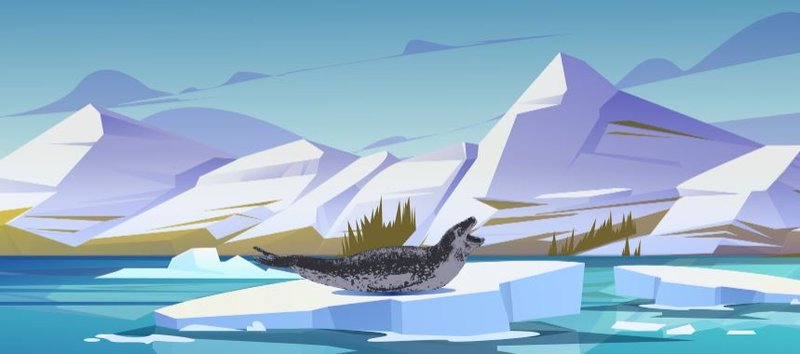
Imagine living in a beautiful, icy world that’s slowly melting away. That’s what leopard seals are experiencing. As the ice that they depend on for hunting and breeding disappears, it’s like their entire neighborhood is being torn down. Let’s dive into the specific ways climate change is shaping the lives of leopard seals and what this means for their future.
Understanding the Leopard Seal
Leopard seals are unique, agile creatures found in the frigid waters of the Antarctic and surrounding regions. They can reach lengths of up to 10 feet and weigh over 1,000 pounds. With their playful demeanor and distinctively spotted coats, they’re more than just a pretty face; they’re apex predators, helping keep the balance in their ecosystem.
In the wild, they primarily feed on krill, fish, and even other seals. This diverse diet ensures they play a significant role in controlling prey populations. But how does climate change affect this hunting strategy? You might be surprised to find out that the prey they rely on is also feeling the heat.
Impact of Melting Ice on Habitats
As global temperatures rise, ice sheets and glaciers in the Antarctic are melting at alarming rates. This isn’t just a sad spectacle; it’s a dire problem for leopard seals. Ice serves as a platform for resting, breeding, and, most crucially, for raising their pups.
When ice melts, these seals have fewer places to haul out. Imagine going to your favorite coffee shop only to find it’s permanently closed—that’s how leopard seals must feel when their breeding spots disappear. With less space, there’s increased competition for food and shelter, which can lead to stress and lower reproductive success.
Furthermore, melting ice can lead to shifts in marine ecosystems. Since leopard seals depend on ice to find their prey, changes in the availability of krill and fish can have a knock-on effect that impacts their entire food web.
Changing Patterns of Prey Availability
Climate change doesn’t just threaten leopard seals’ habitats; it also disrupts their food sources. As the ocean warms, it affects the distribution and abundance of krill—their primary food. Krill thrive in cold, nutrient-rich waters. As these waters warm, krill populations can decline or migrate to cooler areas, making them harder for leopard seals to find.
This shift can lead to *food shortages*, which means leopard seals may have to expend more energy hunting or travel long distances to locate suitable prey. Imagine having to run across town to get your favorite snack; it’s tiring and time-consuming! If leopard seals can’t adapt quickly, their health and populations may decline.
Impact on Reproduction and Pup Survival
Breeding is an essential part of the leopard seal’s life cycle. They typically give birth on sea ice, and the loss of ice means fewer safe spots to nurture their young. When pups are born, they rely on their mothers for warmth and milk in the chilly environment.
If mothers can’t find safe places to care for their pups, or if they struggle to find food due to changing prey patterns, the survival rate of the young can drop dramatically. Just picture trying to raise a baby in a noisy, crowded area without enough food—it’s a tough situation.
With each passing year of climate change, the future for these seals grows more uncertain. Their reproductive success hinges on stable ice environments, and as these become less common, the entire leopard seal population faces threats.
Human Activities and Their Role
While climate change plays a significant role in the struggles of leopard seals, human activities exacerbate the issue. Overfishing, pollution, and increased shipping traffic in the Southern Ocean all contribute to the challenges these seals face.
Overfishing reduces the prey available to leopard seals, while pollution can have direct negative effects on their health and reproduction. Heavy metals and plastics in the ocean create toxic environments that can disrupt ecosystems and harm marine life.
If we think about it, it’s like inviting someone over for dinner and not providing enough food. No one leaves happy, and certain guests might not survive. Similarly, the health of leopard seals is tied to our actions on the planet.
Conservation Efforts for Leopard Seals
Conservation is crucial for the future of leopard seals. Various organizations are working on initiatives to protect their habitats and ensure they have the resources they need to thrive. One way is through protected marine areas, which can help maintain healthy ecosystems and reduce human interference.
Additionally, efforts to combat climate change on a broader scale are essential. This includes reducing greenhouse gas emissions, promoting renewable energy, and raising awareness about the impact of climate change on wildlife. Every small step we take can make a difference for leopard seals.
You might be wondering how you can help. Supporting organizations focused on climate conservation, reducing your carbon footprint, and educating others about these issues can all contribute to a healthier planet for seals and other wildlife.
The Future of Leopard Seals in a Warming World
The future of leopard seals hangs in the balance as climate change continues to reshape their environment. With melting ice, changing prey dynamics, and the challenges posed by human activities, they face an uphill battle for survival.
Here’s the thing: leopard seals are more than just an intriguing species; they are indicators of the health of our oceans. Their struggles reflect larger environmental issues that affect us all. If we care about these incredible creatures and the ecosystems they represent, we must take action now.
We might not be able to reverse climate change overnight, but through awareness and conservation efforts, we can help ensure that leopard seals continue to thrive in their icy home.
In summary, the challenges facing leopard seals due to climate change highlight a broader environmental crisis. By understanding their plight, we can take meaningful steps toward protecting not just them, but our planet as a whole. The stories of such magnificent animals deserve to be told, and more importantly, they deserve a future.
